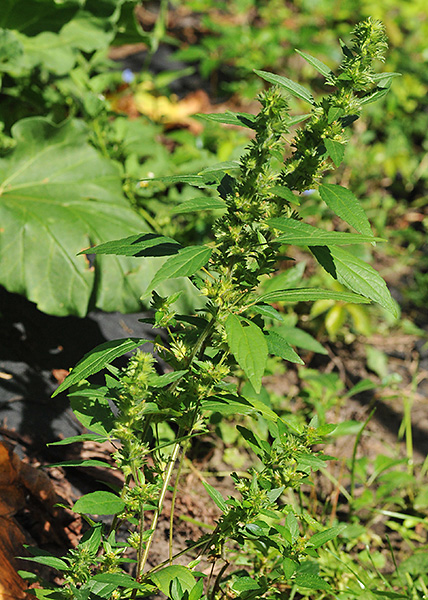
Date: September 14, 2014. Location: Iowa City (private property)
| Classification Hierarchy | |
| Kingdom | Plantae |
| Subkingdom | Tracheophyta |
| Superdivision | Spermatophyta |
| Division | Magnoliophyta |
| Class | Magnoliopsida |
| Subclass | Rosidae |
| Order | Euphorbiales |
| Family | Euphorbiaceae |
| Genus | Acalypha |
| Species | Acalypha virginica |

Date: September 14, 2014. Location: Iowa City (private property)
Scientific Name: Acalypha virginica
Acalypha is derived from "Acalepha" the Greek word for nettle; virginica indicates that the type specimen was found in Virginia. While it bears some resemblance to nettles, it is not prickly.
Common Names: Virginia threeseed mercury, Virginia mercury.
Origin: Native, annual
Notes: Acalypha virginica is a frequent weed in gardens and disturbed areas. Like other members of the Euphorbiaceae it produces very small flowers which lack petals and are easy to overlook. (See discussion below the photos).
Additional references: 1, 2, 3, 4, 5, 6, 7, 8.
Flowers: The plants are monoecious and both staminate and pistillate inflorescences can be found in the folded bracts that emerge from the leaf axils. Staminate inflorescences appear as a spike with several clusters of tiny yellow or red florets each with 4 sepals and standing on a short pedicel. At the base of the peduncle one to five closely grouped flowers constitute the pistillate inflorescence. The flowers lack petals and each consists of three (hard to see) sepals, an ovary, and three divided styles which are fused at the bottom. The ovaries mature, one at a time, into three lobed fruits. On dehiscence, a fruit (Schizocarpic capsule splitting into 3 mericarps) ejects its three seeds as much as 8 cm from the plant.
Leaves: alternate, petioles more than a third of the blade length with a small stipule; lanceolate to rhombic with a crenate (rounded teeth) margin. Under magnification white spots may be visible—as shown below.
Glossaries of botanical terms: 1, 2, 3, 4, 5, 6, 7, 8.
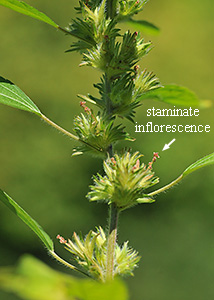

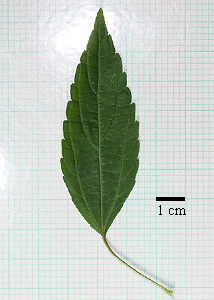
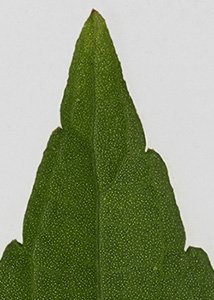
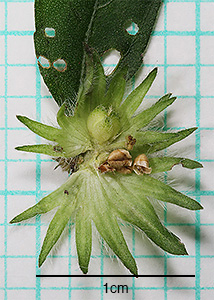
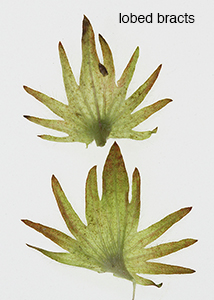
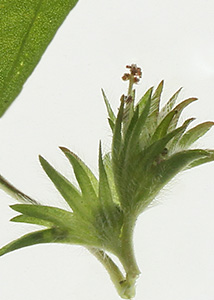
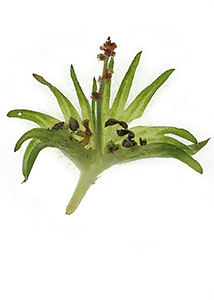
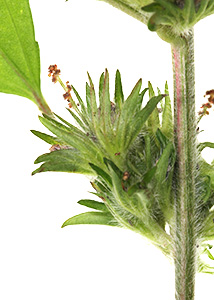
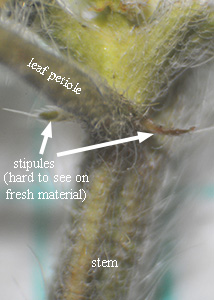
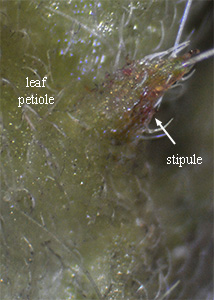

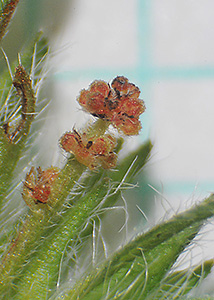
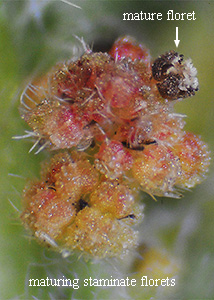
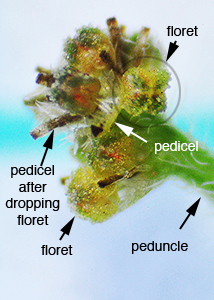
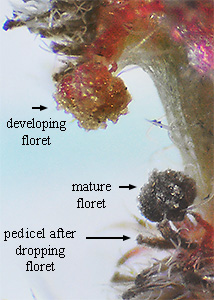
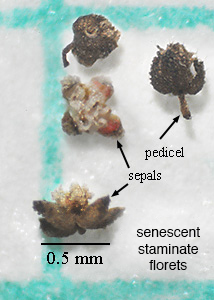
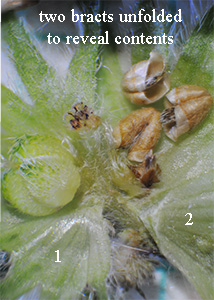
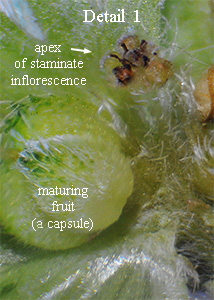

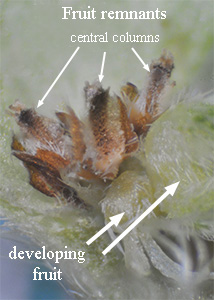
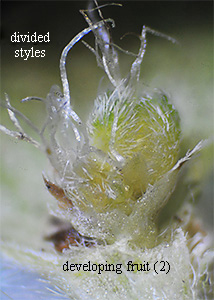

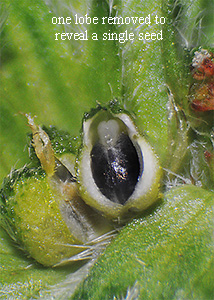
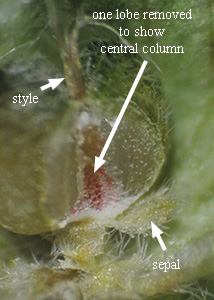
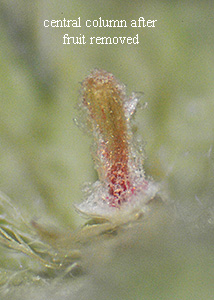
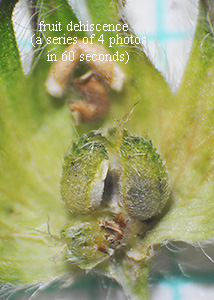
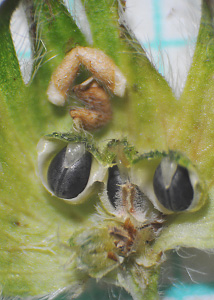
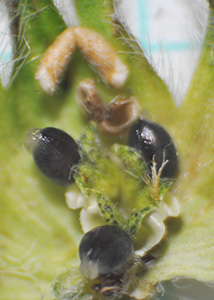
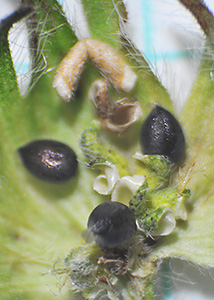
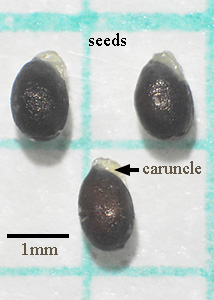
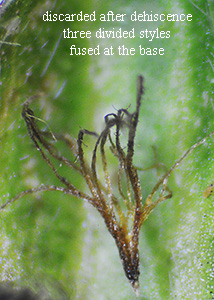
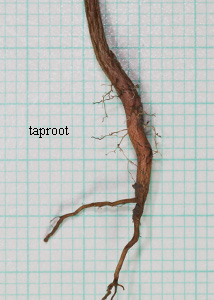
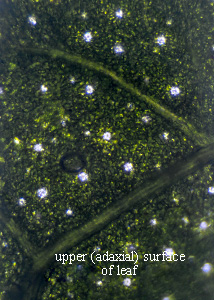
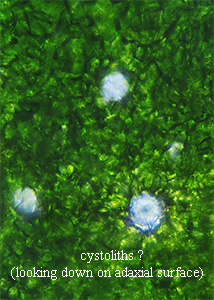
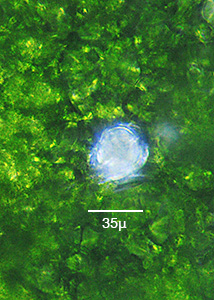
Observations and Speculations:
A more complete written description of characteristics is available online at this FNA site. Rather than repeat those descriptions I would prefer to use this space to mention a few observations (and speculations) that I find interesting about this species.
First, a caution. I haven't found any mention of translucent leaf spots for this plant in my literature or web search. It's possible that the plants shown here are a local aberration. Under the microscope the spots appear particulate, rather than liquid to be crystalline inclusions. Possibly they are calcium carbonate crystals which are known to occur in some leaves, often just below the cells of the upper epidermis.
Second, the Euphorbiaceae family is often associated with a floral structure called a "cyathium". However, the floral structures of some genera in the family—including Acalypha—are not consistant with the usual description of a cyathium and the term won't be used here.
Third, the staminate (male) flowers (called florets) are grouped as an inflorescence on a short stem (peduncle). The tiny florets are about 0.5mm wide, lack petals, appear in tight clusters subtended by a bractiole, and in their early stages are difficult to distinguish as individual structures. As individual florets mature their supports (pedicels) elongate, pollen is produced and their four small sepals become visible as the whole structure darkens. An abscission zone forms in the pedicel a short distance below the floret and with senescence the floret becomes nearly black and drops away from the inflorescence, usually taking a portion of the pedicel along. The greater part of the pedicel remains attached to the peduncle where it appears like a dark strap. In an old inflorescence all of the florets may be gone and what remains are slightly less dense clusters composed of hairs and pedicels.
Fourth, The pistillate (female) flowers have their crowded origins in a small section of tissue next to the base of the staminate peduncle. Pistillate flowers have a 3-locular ovary; the three separate styles are fused together at the base and each unfused portion is further divided at the extremities. They have sepals but lacks petals. The sepals can be hard to see in fresh material. The ovary matures into a three lobed fruit (capsule) with three seeds. Occasionally, one seed is aborted. Fruit development is sequential and generally just one fruit is mature at a time. When it ejects its seeds, twisted bits of the old ovary wall remain and the next ovary grows to take its place. When you unfold one of the protective bracts in a leaf axil, you might see the remnants of one two or three previous capsules along with a mature, and/or one or two immature, developing fruits. When the seeds mature most are black, a few are grey with black speckles. At the narrow end of the seed, near the hilum, is a fleshy translucent structure called a caruncle. There is speculation that its role is to hold moisture to aid in seed germination during dry spells, or perhaps to guide pollen tubes through the micropyle and into the embryo sac. A similar structure in other species called the elaiosome, has been shown to attract ants which aid in the dispersal of the seeds.
Fifth, when you open the folded bracts in mature parts of the plants you may find a seed or two occasionally, but usually they are gone and you might see any or all of several residual structures. Yellow-brown v-shaped structures, usually in groups of three, are dried portions of the fruit coat (pericarp). Upon drying, these split apart and abruptly roll up in a fashion that propels the seeds out of the folded bracts. When a stem bearing fruit structures was left to dry overnight on a sheet of paper, I found a random pattern of seeds around the stem—some as much as eight centimeters from the stem. Remnants also included a structure that is labeled in the photos as "central column" (since that's its position in the 3-parted fruit). As a remnant it was brown and squashed and usually had three bracts (sepals) attached at its base. In cross section the column resembles a three pointed star. It may be the structure from which the fused portion of the style was attached but whatever its function is also seems to anchor the fruit to its base tissue and perhaps the young ovules to the immature fruit. The remains of the three part style may also be seen. It appears as a yellow or brown dendritic thread like structure.
Sixth, There are two species that are sometimes confused with Acalypha virginica—one is closely related (A. rhomboidea) and one is not (Parietaria pensylvanica). A convenient distinction between A. virginica [Virginia three-seeded Mercury] and A. rhomboidea [common three-seeded Mercury] is the size of the leaf petioles and the number of lobes on the folded bracts that enclose the floral parts of the plant.
A. virginica has shorter petioles (less than half the length of the blade) and has 9 to 15 lobes and A. rhomboidea has longer petioles (more than half the length of the blade) and fewer lobes on the folded bracts (5 to 9 lobes) (see Go Botany). The plant in the photos above had mostly 10 lobed bracts. There were also some with 9 and some with 11 bracts. The second species that is sometimes confused with Acalpha spp. is Parietaria pensylvanica (Pennsylvania pellitory), a member of the nettles family. A convenient distinction between these two species is the leaf margins. A. virginica has toothed leaf margins and Parietaria pensylvanica has smooth leaf margins (see this Illinois wildflower website). A second distinction is the fruit— a three seeded capsule for Acalpha and a single seeded achene for Parietaria. There are photos at the Go Botany site. Neither plant has the stinging hairs often associated with nettles.